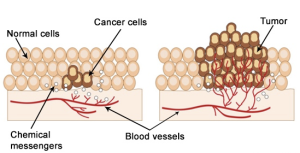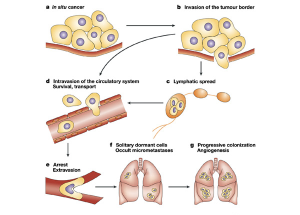Normal cells and Cancer Cells
The human body is formed by 60,000 billions cells. The cell is the simplest element with life that forms the tissues and the organs.
The cellular membrane of the cell protects and separates it from the environment. Inside the cell there are different components: one of them is the nucleus where the DNA is kept.
The cell division is controlled and organised in normal cells. The cells split into two and replace those cells that are defective or dead. Their aim is to preserve the shape of the tissues and respect their functions. Every cell has a cellular life program to grow and die.
The lifetime of the cell depends on the DNA. Some cells have shorter lifetimes such as the cells from the intestine, which existence last about two weeks; in contrast, red blood cells live for three months.
The nucleus has chromosomes that contain genes made of DNA. Sometimes these genes undergo a change (mutation). Then, the cells multiply uncontrolledly: each new cell produced contains the same mutation. Those cells progress chaotically and form a tumour.
Cancer cells have different features: distinct shape, bigger or smaller nucleus, etc. These cells are unable to do their normal functions. Generally, their cell division is faster than the normal cells because of the loss of growth control.
However, sometimes these cancer cells just simply die or are destroyed by the lymph nodules (immune system). But often these cells are alive and start to divide, multiply and grow.
What is Cancer?
Cancer is a disease where normal cells from our body lose both proliferation and growth control. Cancer comes from normal cells, which have been transformed (changed) into tumour cells.
Cancer cells have different features, being invasive one of them. They are able to go to other tissues, migrate to the bloodstream and produce metastasis.
A metastasis is a malignant tumour which cells, derived from itself, are located in a different site.
How and why a normal cell becomes a cancer cell
When a tumour grows, if there is not angiogenesis, the distal cells will die because of no irrigation.
The tumour cell forms new blood vessels (angiogenesis) to survive. These blood vessels will supply the tumor with oxygen and nutrients. Some of them are also able to escape.
The tumour becomes dangerous when the cancer cells invade adjacent areas through the vessels and spread into surrounding organs.
Cancer cells, mainly, segregate two types of proteins which permit their entrance into the bloodstream:
– Proteases: break the basal lumen and enable the cells to migrate to other tissues.
– Integrins: promote adhesion between cells – cells and tissues.
The metastasis is the term used for the spreading process that follows the next steps:
- Local invasion.
- Intravasion.
- Survival in the bloodstream.
- Extravasion.
- Colonization.
Take a look at this video from YouTube. It is very useful to understand the progress from a healthy cell to a tumour cell.




